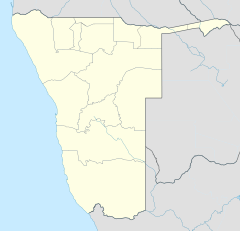Shark Island Concentration Camp
| Shark Island | |
|---|---|
| Concentration camp | |
| Coordinates | 26°38′45″S 15°9′14″E / 26.64583°S 15.15389°ECoordinates: 26°38′45″S 15°9′14″E / 26.64583°S 15.15389°E |
| Location | Luderitz, German South West Africa |
| Operated by | Imperial German Army |
| Original use | Officially a prisoner of war camp, in reality a civilian internment camp, described by some as a death camp or even extermination camp |
| Operational | 1905–1907 |
| Inmates | Herero, Nama |
| Killed | unknown (estimated at least 1,032 up to 3,000) |
Shark Island Concentration Camp or "Death Island" (Konzentrationslager auf der Haifischinsel vor Lüderitzbucht) was one of the five Namibian concentration camps located on Shark Island off Lüderitz, Namibia. It was used by the German empire during the Herero and Namaqua genocide of 1904–1908. Between 1,032 and 3000 Herero and Namaqua men, women, and children died in the camp between its opening in 1905 and its closing in April 1907.
On 12 January 1904, the Herero people rebelled against German colonial rule under the leadership of Samuel Maharero. Origins of the Herero revolt date back to the 1890s when tribes settled in Namibia came under pressure from the growing number of German settlers wanting their land, cattle, and labor. Factors such as loss of property, increasing debt in an attempt to resettle lost herds, low wages on white-owned farms, and racial inequalities only intensified the hostility between the Herero and the Germans. When the Herero rebelled, they killed over 100 German settlers near the town of Okahandja. Over 15,000 German reinforcements under the command of Lothar Von Trotha defeated the Herero force at the Waterberg River in August 1904. Two months later, the Nama people broke out in a similar rebellion against German colonists. Traditional rivalries prevented the Herero and Nama from joining together, however both groups continued fighting guerrilla warfare against the German colonial forces. Following the abandonment of Lothar von Trotha's policy of exterminating Herero within the borders of German South West Africa by denying them access to water holes, the colonial authorities adopted a policy of sweeping the bush clear of Herero – both civilians and rebels – and removing them, either voluntarily or by force, to concentration camps.
Although there are records of Herero prisoners-of-war being held in Lüderitz Bay as early as 1904, the first references to a camp at Shark Island and the transfer of large numbers of Herero prisoners from Keetmanshoop are in March 1905. From early on, large numbers of Herero died in the camp, with 59 men, 59 women and 73 children reportedly dying by late May 1905. Despite this high initial rate of mortality on the island which, with its cold climate, was unsuitable for habitation, particularly for people used to the dry, arid climate of the veld, the German authorities continued to transfer people from the interior to the island, ostensibly because of a lack of food in the interior, but also because they wished to use the prisoners as labour in constructing a railway connecting Lüderitz with Aus.
...
Wikipedia

